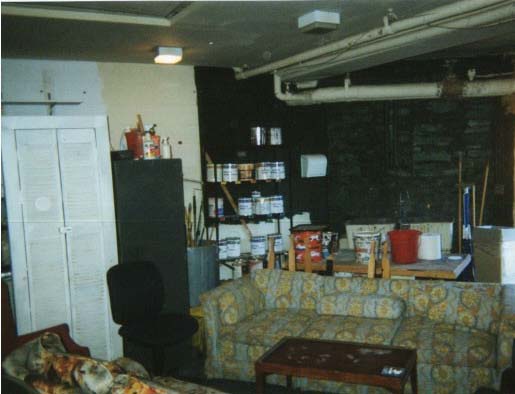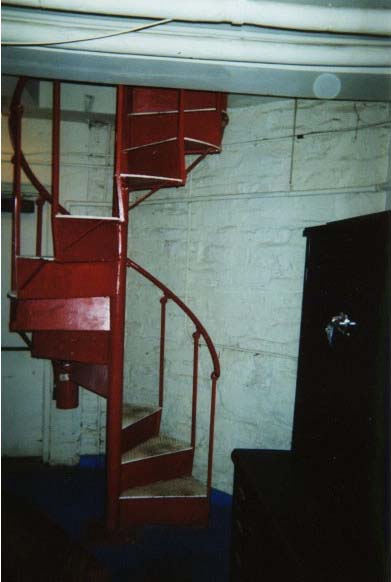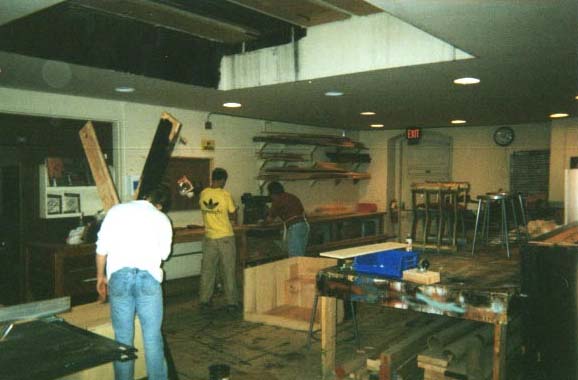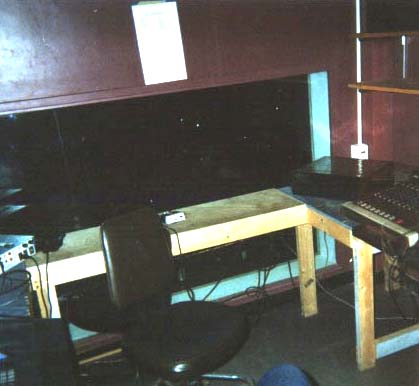 |
| Photograph 1: Because of space constraints, the green room (actors' waiting room) is shared with paint and chemical storage. |
Theatre is at the heart of the liberal arts experience. It gives students not only the tools with which to approach other disciplines with creativity and rigor, but through the process of creating performance it engenders personal responsibility and empowerment; it develops a sense of community both within the creative ensemble and between performance and audience; it teaches students to recognize and honor difference and diversity; it immerses students in unfamiliar cultures through the performance of their arts; and, it helps students to find and develop their own voices and identities.
Hamilton’s program reflects the changing nature of theatre in the context of globalism and multiculturalism. Through a balance of theory and practice, students of theatre gain an understanding of Western performance techniques and dramatic literature, non-Western forms and drama, and non text-based genres of performance. They become acquainted with culturally diverse forms of theatre in the United States, and the ways in which Western forms of theatre increasingly blend with and affect non-Western theatre.
We commit ourselves first and foremost to our students, and the vitality of the theatre program testifies to the success of the collaborative relationship between professor and student. Our program focuses on performance, scholarship, and oral communications skills. More than most Hamilton students, theatre concentrators test their own identities and voices in a public forum. As a result, they must think on their feet, exhibit a commitment to rigor, demonstrate courage in the public eye, meet the challenges posed by difficult texts, solve complex group and individual problems, and create art.
Although one of the College’s smaller departments in terms of faculty, Theatre lies in the middle of all departments in terms of enrollments, averaging 260 students, with 8 to 15 senior concentrators. Students of different ethnicities and cultural backgrounds are well represented in the Department.
Theatre is by nature a multidisciplinary and inclusive activity, with academic connections to such departments and programs as Asian Studies, Art, Music, Africana Studies, English and Communications. In addition, our productions also frequently involve faculty members and students from outside the Theatre program in both advisory and participatory capacities.
In theatre, the interaction between professor and student necessitates a third partner--space. Theatre is a temporal and spatial art form and requires appropriate and sufficient laboratory spaces in order to be taught effectively. We currently lack effective teaching and performance spaces.
Hamilton College’s current facilities are technologically outdated, poorly equipped, and overused. Minor Theatre’s shortcomings have been amply documented: as far back as 1983 Jules Fisher, the country’s leading theatre design consultant, remarked “By almost any standard that might be applied, the Minor Theatre would be deemed inferior.” Since that time, the building has further deteriorated, to the point where the lack of adequate facilities holds the department back in many ways, including:
We envision a facility centered on our students, providing a new locus for creative activity on the campus, enriching the campus culture and enhancing the experience of all Hamilton students, whether or not they are directly involved in making theatre. This facility will reflect both the focus and the pedagogy of the Theatre program.
The teaching of theatre requires several different kinds of spaces:
A new theatre facility would enable the Department to provide our students with the best possible education in the field; it would enable us to expand the kinds of productions we are able to mount; it would provide students with vastly-improved performance and teaching venues; and, it would add immeasurably to the student culture, providing a place for the presentation and discussion of timely cultural, political and social issues.
 |
| Photograph 1: Because of space constraints, the green room (actors' waiting room) is shared with paint and chemical storage. |
 |
| Photograph 2: The sole access to the stage from the dressing rooms is via this dangerous and narrow spiral staircase. |
 |
| Photograph 3: The scene shop is cramped and too small to paint set pieces, which must be transferred and painted on the stage, thus disrupting rehearsal times. |
 |
| Photograph 4: As in many other sections of the building, panels in the ceiling of the costume shop are falling down. |
 |
| Photograph 5: The lighting and sound control booth of the building is cramped and jerry-rigged and is placed so that in many configurations the stage cannot be seen. |